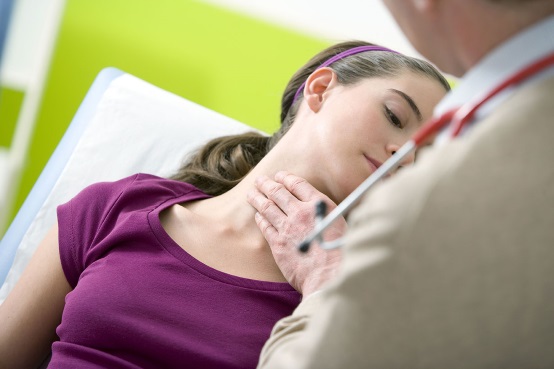Thyroid Conditions
Thyroid Conditions


What are the main Thyroid Dysfunctions?
What are the Causes of Hypothyroidism?
What are the Signs and Symptoms of Hypothyroidism?
- Lack of energy
- Slow metabolism resulting in weight gain
- Lack of energy
- Thinning hair
- Hoarseness
- Increased sensitivity to cold
- Slow heart rate less than 60 beats per minute
- Depression
- Impaired memory
- Pain, stiffness and swelling of muscles and joints
- Dry, puffy, pale skin
If you experience some of the above signs and symptoms, consult your doctor.
What are the Risk Factors for Hypothyroidism?
- Affects females more than males
- History of an autoimmune condition
- Family history of thyroid disease
- Received radiation (neck) or radioactive iodine therapy
- Thyroid surgery
- Pregnancy
How is Hypothyroidism Diagnosed?
- Diagnosing hypothyroidism is usually straightforward by means of a blood test, measuring the hormone thyrotropin (THS).
- TSH is produced by your pituitary gland to signal your thyroid gland to release more or less thyroid hormone.
- A TSH level within the normal range (0.4–2.5 mU/l) will exclude any significant malfunction of your thyroid gland.
- If the TSH level is just above the upper range of normal (above 2.5 mU/l), it is possible that you may develop hypothyroidism in the future.
- If the TSH level is elevated (above 4 mU/l), it is quite likely that you suffer from hypothyroidism, in which case more tests are now needed to confirm the diagnosis, assess the degree and determine the cause.3
How is Hypothyroidism Treated?
- The thyroid pre-hormone levothyroxine is usually effective on its own in the treatment of hypothyroidism.11
- In rare occasions levothyroxine needs to be combined with triiodothyronine (T3) in order to achieve optimal metabolic control.6
What to Expect living with Hypothyroidism?
- Your doctor will establish the correct dose of thyroid hormone for you
- Schedule regular check-ups with your doctor
- Be compliant to medication therapy
- With your hypothyroidism controlled, you will be able to live an entirely normal healthy life with a normal life span
- If the capacity of your thyroid gland to produce adequate amounts of thyroid hormone is compromised, additional thyroid hormone must be supplied externally
- Pregnant women are at greater risk of developing hypothyroidism than the general population, as Oestrogens and other male and female hormones can affect the way your body handles thyroid hormones
- New mothers also have a greater chance of developing a thyroid disorder within the first months after delivery, partly because a deregulated immune system may cause postpartum thyroiditis
- Screening for thyroid disorders during early pregnancy and postpartum is therefore of utmost importance.10
What are the Causes of Hyperthyroidism?
What are the Signs and Symptoms of Hyperthyroidism?
- Weight loss
- Insomnia
- Irritability
- Excessive sweating
How is Hyperthyroidism Diagnosed?

How is Hyperthyroidism Treated?
- Anti-thyroid medication
- Radioactive iodine treatment
- Surgical removal of the thyroid gland or nodule
A Word on Thyroid Nodules
- Therefore, nodules generally need further investigating by the doctor
- If the nodule is producing excessive amounts of thyroid hormone then the person will have symptoms of hyperthyroidism9,10
- Nobody is sure why people develop thyroid nodules, but a lack of dietary intake of iodine is thought to be a factor10
Medical References
From Causes of Thyroid Dysfunction material given in black in content: 1. American Thyroid Association. Thyroid Function Tests. 2005 http://www.thyroid.org/patients/brochures/FunctionTests_brochure.pdf. Accessed March 2009. 2. American Thyroid Association. ATA Hypothyroidism Booklet. Falls Church, VA 2003. 3. American Thyroid Association. Hyperthyroidism. 2005 http://www.thyroid.org/patients/brochures/Hyper_brochure.pdf Accessed March 2009. 4. Roberts CG, Ladenson PW. Hypothyroidism. Lancet. 2004; 363: 793–803. 5. Families online. http://www.familiesonline.co.uk/article/articleview/114/1/12. Accessed March 2009. 6. American Association of Clinical Endocrinologists. Hashimoto thyroiditis http://www.aace.com/pub/thyroidbrochures/pdfs/Hashimoto.pdf. Accessed March 2009. 7. American Thyroid Association. Hypothyroidism. 2005 http://www.thyroid.org/patients/brochures/Hypo_brochure.pdf Accessed March 2009. 8. Bettendorf M. Thyroid disorders in children from birth to adolescence. Eur J Nucl Med Mol Imaging. 2002; 29 Suppl 2: S439–46. 9. American Thyroid Association. Cancer of the thyroid. http://www.thyroid.org/patients/brochures/ThyroidCancer_brochure.pdf Accessed March 2009. 10. American Thyroid Association. Thyroid nodules. 2005 http://www.thyroid.org/patients/brochures/Nodules_brochure.pdf Accessed March 2009. References from Balancing Your Thyroid Gland Given in red in content 1. Khan A, Muzaffar M, Khan A et al. Thyroid Disorders, Etiology and Prevalence. J Med Sci. 2002;2:89-94. 2. Canaris GJ, Manowitz NR, Mayor G et al. The Colorado thyroid disease prevalence study. Arch Intern Med. 2000;160:526-34. 3. American Thyroid Association. ATA Hypothyroidism Booklet. Falls Church, VA 2003 4. American Thyroid Association. Thyroid Function Tests. 2005 http://www.thyroid.org/patients/brochures/FunctionTests_brochure.pdf. Accessed March 2009 5. American Thyroid Association. Hyperthyroidism. 2005 http://www.thyroid.org/patients/brochures/Hyper_brochure.pdf. Accessed March 2009. 6. Ladenson PW; Lancet Vol. 363 No 9411, p 793-803 7. Bettendorf M. Thyroid disorders in children from birth to adolescence. Eur J Nucl Med Mol Imaging. 2002; 29 Suppl 2: S439–46 8. WHO. Iodine defi ciency in 2007: Global progress since 2003 http://www.who.int/nutrition/publications/micronutrients/FNBvol29N3sep08.pdf. Accessed November 2011 9. De Groot LJ, Stagnaro-Green A, Vigersky R. Patient guide to the management of maternal hyperthyroidism before, during and after pregnancy. The Hormone Foundation. 2007 10. Fast Facts For Your Health. Thyroid Disease and Women. National Women’s Health Resource Center. Red Bank, NJ.2006 11. SPC; packaging leaflet of Levothyroxine product






